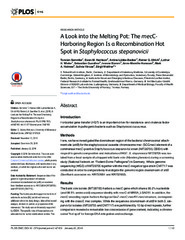| dc.contributor.author | Semmler, Torsten | |
| dc.contributor.author | Harrison, Ewan M. | |
| dc.contributor.author | Lübke-Becker, Antina | |
| dc.contributor.author | Ulrich, Rainer G. | |
| dc.contributor.author | Wieler, Lothar H. | |
| dc.contributor.author | Guenther, Sebastian | |
| dc.contributor.author | Stamm, Ivonne | |
| dc.contributor.author | Hanssen, Anne-Merethe | |
| dc.contributor.author | Holmes, Mark A. | |
| dc.contributor.author | Vincze, Szilvia | |
| dc.contributor.author | Walther, Birgit | |
| dc.date.accessioned | 2016-08-31T07:34:24Z | |
| dc.date.available | 2016-08-31T07:34:24Z | |
| dc.date.issued | 2016-01-22 | |
| dc.description.abstract | INTRODUCTION
Horizontal gene transfer (HGT) is an important driver for resistance- and virulence factor accumulation in pathogenic bacteria such as Staphylococcus aureus.
METHODS
Here, we have investigated the downstream region of the bacterial chromosomal attachment site (attB) for the staphylococcal cassette chromosome mec (SCCmec) element of a commensal mecC-positive Staphylococcus stepanovicii strain (IMT28705; ODD4) with respect to genetic composition and indications of HGT. S. stepanovicii IMT28705 was isolated from a fecal sample of a trapped wild bank vole (Myodes glareolus) during a screening study (National Network on “Rodent-Borne Pathogens”) in Germany. Whole genome sequencing (WGS) of IMT28705 together with the mecC-negative type strain CM7717 was conducted in order to comparatively investigate the genomic region downstream of attB (GenBank accession no. KR732654 and KR732653).
RESULTS
The bank vole isolate (IMT28705) harbors a mecC gene which shares 99.2% nucleotide (and 98.5% amino acid) sequence identity with mecC of MRSA_LGA251. In addition, the mecC-encoding region harbors the typical blaZ-mecC-mecR1-mecI structure, corresponding with the class E mec complex. While the sequences downstream of attB in both S. stepanovicii isolates (IMT28705 and CM7717) are partitioned by 15 bp direct repeats, further comparison revealed a remarkable low concordance of gene content, indicating a chromosomal “hot spot” for foreign DNA integration and exchange.
CONCLUSION
Our data highlight the necessity for further research on transmission routes of resistance encoding factors from the environmental and wildlife resistome. | en_US |
| dc.description.sponsorship | The funder provided support in the form of salaries for authors [IS], but did not have any additional role in the study design, data collection and analysis, decision to publish, or preparation of the manuscript. The study was not financially supported by IDEXX. The specific roles of these authors are articulated in the ‘author contributions’ section. This work was supported by the Federal Ministry of Education and Research (BMBF) through the National Research Platform for Zoonoses (MedVet- Staph, grant no. 01KI1301F to BW) and Network “Rodent-borne Pathogens”; (NaÜPa-net; grant nos. 01KI1018 and 01KI1303 to RGU). TS was financed through BMBF grant FBI-Zoo (grant no. 01KI1012A). The funders had no role in study design, data collection and analysis, decision to publish, or preparation of the manuscript. | en_US |
| dc.description | Publisher's version, source: <a href=http://dx.doi.org/10.1371/journal.pone.0147150>http://dx.doi.org/10.1371/journal.pone.0147150</a>. | en_US |
| dc.identifier.citation | PLoS ONE 2016, 11(1): e0147150 | en_US |
| dc.identifier.cristinID | FRIDAID 1357660 | |
| dc.identifier.doi | 10.1371/journal.pone.0147150 | |
| dc.identifier.issn | 1932-6203 | |
| dc.identifier.uri | https://hdl.handle.net/10037/9599 | |
| dc.identifier.urn | URN:NBN:no-uit_munin_9151 | |
| dc.language.iso | eng | en_US |
| dc.publisher | Public Library of Science | en_US |
| dc.rights.accessRights | openAccess | |
| dc.subject | VDP::Medisinske Fag: 700::Basale medisinske, odontologiske og veterinærmedisinske fag: 710::Medisinsk mikrobiologi: 715 | en_US |
| dc.subject | VDP::Matematikk og Naturvitenskap: 400::Basale biofag: 470::Generell mikrobiologi: 472 | en_US |
| dc.subject | VDP::Matematikk og Naturvitenskap: 400::Basale biofag: 470::Generell immunologi: 478 | en_US |
| dc.title | A Look into the Melting Pot: The mecC-Harboring Region Is a Recombination Hot Spot in Staphylococcus stepanovicii | en_US |
| dc.type | Journal article | en_US |
| dc.type | Tidsskriftartikkel | no |


 English
English norsk
norsk